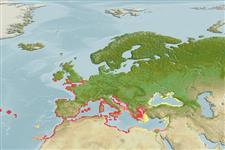Common names from other countries
>
Blenniiformes (Blennies) >
Blenniidae (Combtooth blennies) > Salariinae
Etymology: Coryphoblennius: Greek, koryphe = summit + Greek, belnnios = mucus (Ref. 45335).
More on author: Linnaeus.
Environment: milieu / climate zone / depth range / distribution range
Ecologia
marinhas demersal. Subtropical; 52°N - 20°N, 19°W - 42°E
Eastern Atlantic: along the coasts of western England and the British Channel, Spain, Portugal, France, Morocco, Madeira , Canary Islands; Mediterranean Sea, Sea of Marmara, and the Black Sea.
Tamanho / Peso / Idade
Maturity: Lm ? range ? - ? cm
Max length : 7.6 cm SL macho/indeterminado; (Ref. 5298)
Facultative air-breathing (Ref. 126274); Intertidal (Ref. 31184), found on the wave-battered rocky shores (Ref. 5298). May remain out of water under rocks and seaweeds (Ref. 31184). Omnivorous; feed mainly on copepods and ostracods as juveniles and shift to diet of algae as adults (Ref. 94105). Breathe air when out of water (Ref. 31184). Juveniles in small tide pools (Ref. 41018). Oviparous. Eggs are demersal and adhesive (Ref. 205), and are attached to the substrate via a filamentous, adhesive pad or pedestal (Ref. 94114). Larvae are planktonic, often found in shallow, coastal waters (Ref. 94114). Territories protected by males include depressions, crevices or piddock holes (Ref. 5981).
Ciclo de vida ou comportamento de acasalamento
Maturidade | Reprodução | Desova | Ovos | Fecundidade | Larvas
Distinct pairing (Ref. 205). During mating, the male fans the nest as if cleaning and ventilating the area. Males release sperm during periodic quivers to fertilize eggs in the nest much like other blennies (Ref. 55747). Males guard the egg-masses of various females (Ref. 5981).
Bath, H., 1990. Blenniidae. p. 905-915. In J.C. Quero, J.C. Hureau, C. Karrer, A. Post and L. Saldanha (eds.) Check-list of the fishes of the eastern tropical Atlantic (CLOFETA). JNICT, Lisbon; SEI, Paris; and UNESCO, Paris. Vol. 2. (Ref. 5298)
Status na Lista Vermelha da UICN (Ref. 130435)
CITES (Ref. 128078)
Not Evaluated
Ameaça para os humanos
Harmless
Uso pelos humanos
Pescarias: sem interesse
Mais informação
ReferênciasAquaculturaPerfil para aquaculturaEstirpesGenéticaElectrophoresesHereditariedadeDoençasProcessamentoConversão de massa
ColaboradoresFotosStamps, Coins Misc.SonsCiguateraVelocidadeTipo de nataçãoÁrea branquialOtólitosCérebrosVisão
Ferramentas
Relatórios especiais
Baixar XML
Fontes da internet
Estimates based on models
Preferred temperature (Ref.
115969): 12.5 - 20.8, mean 18.6 (based on 504 cells).
Índice de diversidade filogenética (Ref.
82804): PD
50 = 1.0000 [Uniqueness, from 0.5 = low to 2.0 = high].
Bayesian length-weight: a=0.00741 (0.00335 - 0.01640), b=3.02 (2.83 - 3.21), in cm Total Length, based on LWR estimates for this (Sub)family-body shape (Ref.
93245).
Nível Trófico (Ref.
69278): 2.3 ±0.0 se; based on diet studies.
Resiliência (Ref.
120179): Elevada, tempo mínimo de duplicação da população menor que 15 meses (Preliminary K or Fecundity.).
Fishing Vulnerability (Ref.
59153): Low vulnerability (10 of 100).
